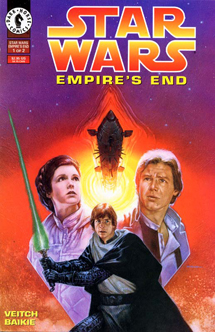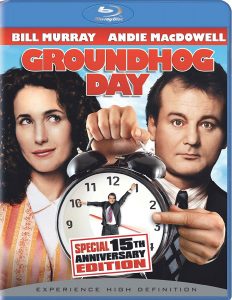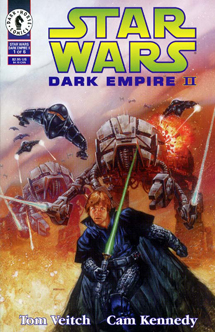“Dark Empire II” and “Empire’s End” (1994-95) are the comics where the Emperor turns into a cartoon. But while “The Clone Wars” is currently doing a great job portraying Palpatine, I mean “cartoon” in a derogatory sense across these eight comic issues.
Tom Veitch has written some great “Star Wars” stuff. The first “Dark Empire” was bolstered a lot by the essays at the end of each issue that lent gravitas to the proceedings. Although some people scoffed at the idea of a resurrected Emperor, I bought it — transferring his essence into a cloned body seemed exactly like something this guy would do. And when he continued to pursue Luke as his apprentice, he was totally in character. By the end of the final issue, Veitch didn’t definitively kill him off, though, and indeed in “Dark Empire II” (which, unfortunately, don’t include essays) we learn that he moved into the one clone body that Luke overlooked.
Without the Luke-Palpatine mind games at the core anymore, the six issues of “Dark Empire II” and two issues of “Empire’s End” find Palpatine scheming to destroy the Rebels (as with the first series, Veitch doesn’t use the term “New Republic”) with his Galaxy Gun (it’s exactly what it sounds like, and it started a horrible trend of superweapons in the Expanded Universe in the 1990s) and capture Leia’s third child to use as his new body (Anakin Solo would be born in “Dark Empire II” No. 6).

The Emperor has quite a cadre of adepts here whom he calls his Dark Jedi. The ret-con, I suppose, is that Palpatine is slowly going insane in his unstable clone body and he doesn’t care about the Rule of Two anymore. But there’s really no good way to explain the scene where he infuses two non-Force-sensitive underlings with the Dark Side to make them into powerful adepts. Such an extreme power has never been hinted at in other stories.
“Dark Empire II” gets off to a weird start from the opening crawl. Just as “Dark Empire” started with a huge event having taken place off-page — the Empire’s takeover of the core worlds from the New Republic — so does the sequel: Luke meets a long-hidden Jedi, Kam Solusar, who is now his second-in-command and a key cog in restarting the Jedi Order. As with the first series, which the writer scrambled to fit into the timeline after the “Thrawn Trilogy,” this wasn’t necessarily Veitch’s fault, as a graphic novel telling of the Luke-and-Kam meeting was canceled for some reason. Still, considering that issue No. 1 spends tons of pages on a huge tech-oriented battle between the Empire and one of its military-industry planets, it seems odd that a much-more epic event like Luke meeting a long-lost Jedi would be skimmed over.
We get more Boba Fett action in “Dark Empire II,” and Fett’s back in the Slave I (for some reason, he was in the Slave II in the first series). As with “Dark Empire,” Han and company escape Fett a bit too easily — the bounty hunter’s failings start to become a bit too Wile E. Coyote-like. Perhaps the most memorable Fett moment is a continuity gaffe, as an Imperial accuses Fett of being a former stormtrooper who turned on his commander. (My ret-con: That was the charge the Empire trumped up if they ever wanted Fett out of the picture. It’s a blatant lie, since Fett was never even in the Imperial forces, but the Empire under the clone-bodied Palpatine is at its most openly, arrogantly evil.)

The most surprising thing in “Dark Empire II”/”Empire’s End” is that Luke has a brief fling with one of his earliest Jedi students, Jem Ysanna. I remember Luke’s short-lived relationships from the novels such as Gaeriel and Callista, but I had totally forgotten about this liaison. And with good reason — it only lasts a couple of issues before Jem bites the dust, and there’s really no emotional thrust to any of it.
I don’t want to give the sense that these eight issues are completely awful. Veitch still gets the pacing of “Star Wars” down quite well, and there’s one evocative setting — the space city of Nespis VIII — that’s like something out of a Ralph McQuarrie painting. And it’s nice to visit Onderon and Korriban and the concept of Jedi Battle Meditation, thus making a link through the years between Nomi Sunrider and Leia.
The major problem, though, is that the Emperor overstays his welcome as a compelling character. Maybe “Empire’s End” was trimmed to two issues instead of six because even the Dark Horse editors had had enough of ol’ Palps. The teaser for the saga’s final issue reads: It “appears to finally be … could it really be … once and for all … the Emperor’s end?” The answer is yes — thank goodness.

